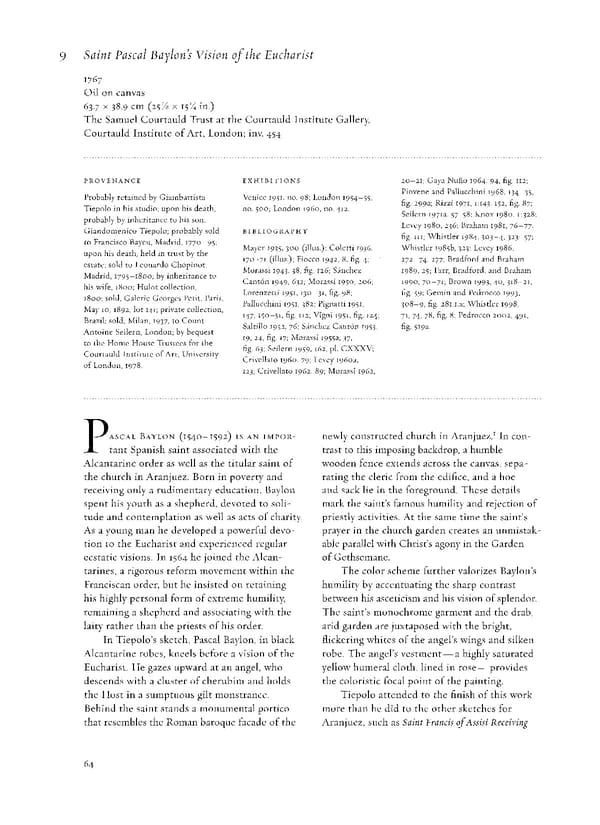9 Saint Pascal Baylon s Vision of the Eucharist 1767 Oil on canvas 63.7 x 38.9 cm (25/8 x 15 Y in.) 4 The Samuel Courtauld Trust at the Courtauld Institute Gallery, Courtauld Institute of Art, London; inv. 454 PROVENANCE EXHIBITIONS 20-21; Gaya Nuno 1964, 94, fig. 112; Probably retained by Giambattista Venice 1951, no. 98; London 1954-55, Piovene and Pallucchini 1968, 134-35, Tiepolo in his studio; upon his death, no. 500; London 1960, no. 412. fig. 299a; Rizzi 1971, 1:143, 152, fig. 87; probably by inheritance to his son, Seilern I97ia, 57-58; Knox 1980, 1:328; Levey 1980, 236; Braham 1981, 76—77, Giandomenico Tiepolo; probably sold BIBLIOGRAPHY fig. in; Whistler 1984, 303-4, 323-57; to Francisco Bayeu, Madrid, 1770-95; Mayer 1935, 300 (illus.); Coletti 1936, Whistler 1985^ 323; Levey 1986, upon his death, held in trust by the 170-71 (illus.); Fiocco 1942, 8, fig. 4; 272-74, 277; Bradford and Braham estate; sold to Leonardo Chopinot, Morassi 1943, 38, fig. 126; Sanchez 1989, 25; Farr, Bradford, and Braham Madrid, 1795-1800; by inheritance to Canton 1949, 632; Morassi 1950, 206; 1990, 70-71; Brown 1993, 40, 318-21, his wife, 1800; Hulot collection, Lorenzetti 1951, 130-31, fig. 98; fig. 59; Gemin and Pedrocco 1993, 1800; sold, Galerie Georges Petit, Paris, Pallucchini 1951, 382; Pignatti 1951, 308-9, fig. 281.i.a; Whistler 1998, May 10, 1892, lot 141; private collection, 147, 150-51, fig. 112; Vigni 1951, fig. 124; 71, 74, 78, fig. 8; Pedrocco 2002, 491, Brazil; sold, Milan, 1937, to Count Saltillo 1952, 76; Sanchez Canton 1953, fig. 5i9a. Antoine Seilern, London; by bequest 19, 24, fig. 17; Morassi I955a, 37, to the Home House Trustees for the fig. 63; Seilern 1959, 162, pi. CXXXV; Courtauld Institute of Art, University Crivellato 1960, 79; Levey I96oa, of London, 1978. 123; Crivellato 1962, 89; Morassi 1962, P ASCAL BAYLON (1540-1592) is AN IMPOR- newly constructed church in Aranjuez.1 In con- ptant Spanish saint associated with the trast to this imposing backdrop, a humble Alcantarine order as well as the titular saint of wooden fence extends across the canvas, sepa- the church in Aranjuez. Born in poverty and rating the cleric from the edifice, and a hoe receiving only a rudimentary education, Baylon and sack lie in the foreground. These details spent his youth as a shepherd, devoted to soli- mark the saint's famous humility and rejection of tude and contemplation as well as acts of charity. priestly activities. At the same time the saint's As a young man he developed a powerful devo- prayer in the church garden creates an unmistak- tion to the Eucharist and experienced regular able parallel with Christ's agony in the Garden ecstatic visions. In 1564 he joined the Alcan- of Gethsemane. tarines, a rigorous reform movement within the The color scheme further valorizes Baylon's Franciscan order, but he insisted on retaining humility by accentuating the sharp contrast his highly personal form of extreme humility, between his asceticism and his vision of splendor. remaining a shepherd and associating with the The saint's monochrome garment and the drab, laity rather than the priests of his order. arid garden are juxtaposed with the bright, In Tiepolo's sketch, Pascal Baylon, in black flickering whites of the angel's wings and silken Alcantarine robes, kneels before a vision of the robe. The angel's vestment—a highly saturated Eucharist. He gazes upward at an angel, who yellow humeral cloth, lined in rose — provides descends with a cluster of cherubim and holds the coloristic focal point of the painting. the Host in a sumptuous gilt monstrance. Tiepolo attended to the finish of this work Behind the saint stands a monumental portico more than he did to the other sketches for that resembles the Roman baroque facade of the Aranjuez, such as Saint Francis ofAssisi Receiving 64
 Giambattista Tiepolo: Fifteen Oil Sketches Page 64 Page 66
Giambattista Tiepolo: Fifteen Oil Sketches Page 64 Page 66